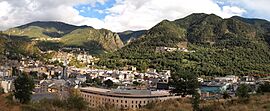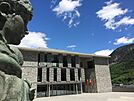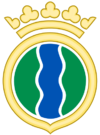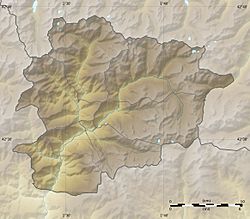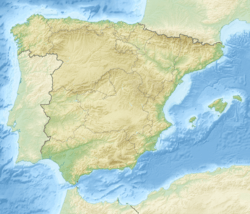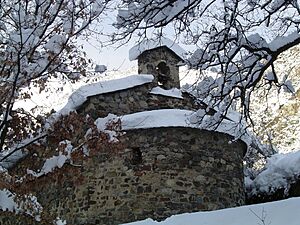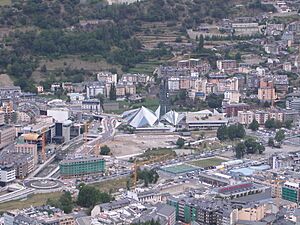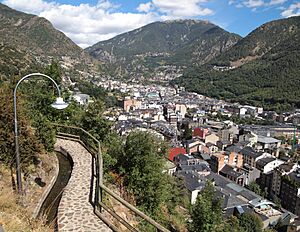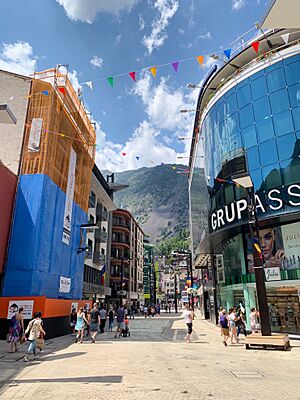Andorra la Vella facts for kids
Quick facts for kids
Andorra la Vella
|
|||
|---|---|---|---|
|
View from a northern side of the Andorra la Vella, Consell General d'Andorra, Casa de la Vall, Centric Hotel, Church of Saint Stephen, Massip-Dolsa house, Andorra in 1986, La Valira,
|
|||
|
|||
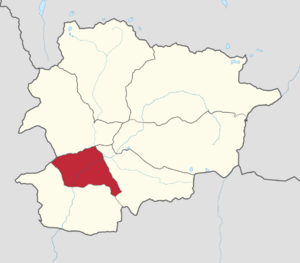
Location within Andorra
|
|||
| Country | Andorra | ||
| Parishes | Andorra la Vella | ||
| Villages | La Margineda, Santa Coloma | ||
| Area | |||
| • Total | 12 km2 (5 sq mi) | ||
| Elevation | 1,023 m (3,356 ft) | ||
| Population
(2011)
|
|||
| • Total | 22,256 | ||
| Demonyms | Andorran andorrà, andorrana (ca) |
||
| Website | Official site: http://www.andorralavella.ad/ | ||
Andorra la Vella is the capital and largest city of Andorra. It is located high in the eastern Pyrenees mountains, between France and Spain. It is also the name of the area (called a parish) that surrounds the capital city.
As of 2015, the city has about 22,886 people living there. If you include the nearby town of Escaldes-Engordany and other small villages, the total population is over 40,000.
The main business in Andorra la Vella is tourism. Many people visit for holidays. The country also earns money because it is a tax haven. This means it has very low taxes, which attracts businesses and wealthy people. Local products include furniture and brandies. At 1,023 meters (3,356 feet) above sea level, it is the highest capital city in Europe. It is also a popular place for skiing. The city has a small border with Spain.
Contents
What's in a Name?
The name Andorra la Vella means "the city of Andorra." This helps to tell it apart from the whole country of Andorra. The word Vella comes from a Latin word meaning "city," not "old."
A Look at History
People have lived in the area of Andorra la Vella since before the time of Christ. The Andosin tribe lived here in the late Neolithic period. The country of Andorra was created and protected by Charlemagne in the 700s. It was a buffer zone against the Moors who lived in the Iberian Peninsula.
Andorra la Vella has been the main city of Andorra since 1278. This was when the French and Episcopal co-princes agreed to share control. The old part of Andorra la Vella, called the Barri Antic, has streets and buildings from this time. The most famous building is the Casa de la Vall. It was built in the early 1500s and has been the country's parliament building since 1702. For a long time, Andorra la Vella was the capital of a very isolated country. It stayed independent because of this shared rule.
For much of the 1900s, Andorra la Vella was not well-known. After some political problems in the 1930s, a more informal democracy began. In 1993, Andorra got its first constitution. This made the government a formal democracy with different branches (executive, legislative, and judicial) all located in Andorra la Vella.
During this time, Andorra also became known as a tax haven. This led to many modern bank offices being built in Andorra la Vella. The city also improved its skiing facilities. Andorra la Vella even tried to host the 2010 Winter Olympics, but it was not chosen. However, it did host the Games of the Small States of Europe in 1991 and 2005.
Where is Andorra la Vella?
Andorra la Vella is in the southwest of Andorra. It is located where two mountain streams meet: the Valira del Nord and the Valira de l'Orient. These streams then form the Gran Valira river. The city is right next to the town of Escaldes-Engordany. It sits at 1,023 meters (3,356 feet) above sea level.
Weather in Andorra la Vella
Andorra la Vella has an oceanic climate. This means it has warm days and cool nights in summer. Winters are chilly to cold and snowy. The city gets about 812 millimeters (32 inches) of rain each year. The high altitude makes the temperatures cooler than in lower areas.
| Climate data for Andorra La Vella (Roc de Sant Pere), elevation: 1,075m (1971–2000, extremes 1934–present) | |||||||||||||
|---|---|---|---|---|---|---|---|---|---|---|---|---|---|
| Month | Jan | Feb | Mar | Apr | May | Jun | Jul | Aug | Sep | Oct | Nov | Dec | Year |
| Record high °C (°F) | 18.0 (64.4) |
20.0 (68.0) |
24.8 (76.6) |
29.0 (84.2) |
29.2 (84.6) |
37.4 (99.3) |
39.0 (102.2) |
35.9 (96.6) |
32.0 (89.6) |
31.0 (87.8) |
21.2 (70.2) |
19.0 (66.2) |
39.0 (102.2) |
| Mean daily maximum °C (°F) | 6.9 (44.4) |
8.9 (48.0) |
11.7 (53.1) |
13.3 (55.9) |
17.6 (63.7) |
21.9 (71.4) |
26.2 (79.2) |
25.4 (77.7) |
21.4 (70.5) |
16.0 (60.8) |
10.7 (51.3) |
7.5 (45.5) |
15.6 (60.1) |
| Daily mean °C (°F) | 2.2 (36.0) |
3.5 (38.3) |
5.8 (42.4) |
7.5 (45.5) |
11.5 (52.7) |
15.4 (59.7) |
18.8 (65.8) |
18.5 (65.3) |
14.9 (58.8) |
10.3 (50.5) |
5.7 (42.3) |
3.0 (37.4) |
9.8 (49.6) |
| Mean daily minimum °C (°F) | −2.5 (27.5) |
−1.8 (28.8) |
−0.2 (31.6) |
1.7 (35.1) |
5.3 (41.5) |
8.8 (47.8) |
11.4 (52.5) |
11.4 (52.5) |
8.5 (47.3) |
4.7 (40.5) |
0.6 (33.1) |
−1.4 (29.5) |
3.9 (39.0) |
| Record low °C (°F) | −15 (5) |
−16 (3) |
−11 (12) |
−7 (19) |
−2 (28) |
0.0 (32.0) |
3.0 (37.4) |
2.0 (35.6) |
0.0 (32.0) |
−6 (21) |
−13 (9) |
−19.5 (−3.1) |
−19.5 (−3.1) |
| Average precipitation mm (inches) | 53.1 (2.09) |
37.9 (1.49) |
40.5 (1.59) |
71.2 (2.80) |
89.8 (3.54) |
84.2 (3.31) |
60.7 (2.39) |
85.6 (3.37) |
80.9 (3.19) |
72.4 (2.85) |
68.4 (2.69) |
67.9 (2.67) |
812.3 (31.98) |
| Source 1: ACDA | |||||||||||||
| Source 2: Meteo Climat (record highs and lows) | |||||||||||||
Parts of the Parish
The parish of Andorra la Vella is divided into a few villages. These include Andorra la Vella city itself, La Margineda, and Santa Coloma.
Famous Places
The old town of Andorra la Vella has charming old stone streets and houses. The central Església de Sant Esteve (Saint Stephen) church is a beautiful part of the city. It was built in a Romanesque style in the 11th century. As mentioned, the old town also has the country's historic parliament building. The oldest building in the city is likely the Church of Santa Coloma d'Andorra, which dates back to the 9th century.
Who Lives There?
| Nationality | Population (2013) |
|---|---|
| 6,516 | |
| 3,377 | |
| 664 | |
| 246 | |
| 218 |
Only about one-third (33%) of the people living in Andorra la Vella are native Andorrans. Most residents are Spanish (43%), with many Portuguese (11%) and French (7%) people as well. Most people living here are Roman Catholics. People in Andorra la Vella tend to live a long time, with a life expectancy of over 80 years.
Culture and Fun
The city is the main cultural hub of Andorra. The Government Exhibition Hall is a major theater and museum. The square outside the parliament building hosts many events. The town also has a music festival every winter.
Languages Spoken
Catalan is the official language of Andorra. However, many people also speak Spanish, Portuguese, and French.
Famous People from Andorra la Vella
- Elidà Amigó i Montanya (1935–2020) was a historian and activist. She was a leader in the movement for women's suffrage (the right for women to vote) in Andorra.
- Marc Forné Molné (born 1946) was the Prime Minister of Andorra from 1994 to 2005.
- Lluís Claret (born 1951) is a famous cellist, known for playing chamber music.
- Jaume Bartumeu (born 1954) is a lawyer and politician. He served as the head of government from 2009 to 2011.
- Juli Minoves (born 1969) is a diplomat and author. He was also the 13th President of Liberal International.
- Pere López Agràs (born 1971) is a politician who was acting Prime Minister in 2011.
Sports Stars
- Javier Sánchez (born 1968) is a former professional tennis player.
- Sophie Dusautoir Bertrand (born 1972) is a ski mountaineer.
- Marc Bernaus (born 1977) is a retired footballer who played as a left back.
- Marta Roure (born 1981) is a singer and actress.
- Xavier Cardelús (born 1998) is a motorcycle rider.
Money and Travel
Andorra la Vella is the main business center of the country. About 80% of Andorra's total income comes from the 10 million tourists who visit each year. The city is also a hub for many banks and businesses. These businesses do well because of Andorra's tax haven status (low taxes). Andorra is not part of the European Union, but it has a special trade agreement with the EU and uses the euro currency.
Getting Around
Andorra la Vella has helicopter flights from the Andorra la Vella Heliport in the city center. The Andorra–La Seu d'Urgell Airport is about 24 kilometers (15 miles) south of the city, in Spain. It has flights to other parts of Spain. For international flights, the closest airports are in Perpignan (France) and Lleida (Spain). Larger airports are in Toulouse, Girona, and Barcelona.
Andorra la Vella does not have a train station. However, there are bus services that connect the city to train stations in L'Hospitalet-près-l'Andorre (France) and Lleida (Spain). There are also shuttle buses from the airports in Barcelona, Girona, and Reus to Andorra la Vella.
Learning in Andorra la Vella
The Instituto Español de Andorra (IEA) is a Spanish international secondary school located in La Margineda, which is part of Andorra la Vella. There is also a Spanish primary school called Escuela Española de Andorra la Vella.
Global Connections
Andorra la Vella has "twin town" and "sister city" relationships with other cities around the world.
Twin Towns – Sister Cities
Andorra la Vella is twinned with these cities:
 Sant Pol de Mar, Spain
Sant Pol de Mar, Spain Valls, Spain
Valls, Spain Foix, France
Foix, France Šid, Serbia
Šid, Serbia
Union of Ibero-American Capital Cities
Since 2008, Andorra la Vella has been part of the Union of Ibero-American Capital Cities. This means it has friendly relationships with many capital cities in Spanish and Portuguese-speaking countries:
 Asunción, Paraguay
Asunción, Paraguay Barcelona, Spain
Barcelona, Spain Bogotá, Colombia
Bogotá, Colombia Brasília, Brazil
Brasília, Brazil Buenos Aires, Argentina
Buenos Aires, Argentina Cádiz, Spain
Cádiz, Spain Caracas, Venezuela
Caracas, Venezuela Guatemala City, Guatemala
Guatemala City, Guatemala Havana, Cuba
Havana, Cuba Quito, Ecuador
Quito, Ecuador La Paz, Bolivia
La Paz, Bolivia Lima, Peru
Lima, Peru Lisbon, Portugal
Lisbon, Portugal Madrid, Spain
Madrid, Spain Managua, Nicaragua
Managua, Nicaragua Mexico City, Mexico
Mexico City, Mexico Montevideo, Uruguay
Montevideo, Uruguay Panama City, Panama
Panama City, Panama Port-au-Prince, Haiti
Port-au-Prince, Haiti Rio de Janeiro, Brazil
Rio de Janeiro, Brazil San Jose, Costa Rica
San Jose, Costa Rica San Juan, Puerto Rico
San Juan, Puerto Rico San Salvador, El Salvador
San Salvador, El Salvador Santiago, Chile
Santiago, Chile Santo Domingo, Dominican Republic
Santo Domingo, Dominican Republic São Paulo, Brazil
São Paulo, Brazil Sucre, Bolivia
Sucre, Bolivia Tegucigalpa, Honduras
Tegucigalpa, Honduras
Images for kids
See also
 In Spanish: Andorra la Vieja para niños
In Spanish: Andorra la Vieja para niños


